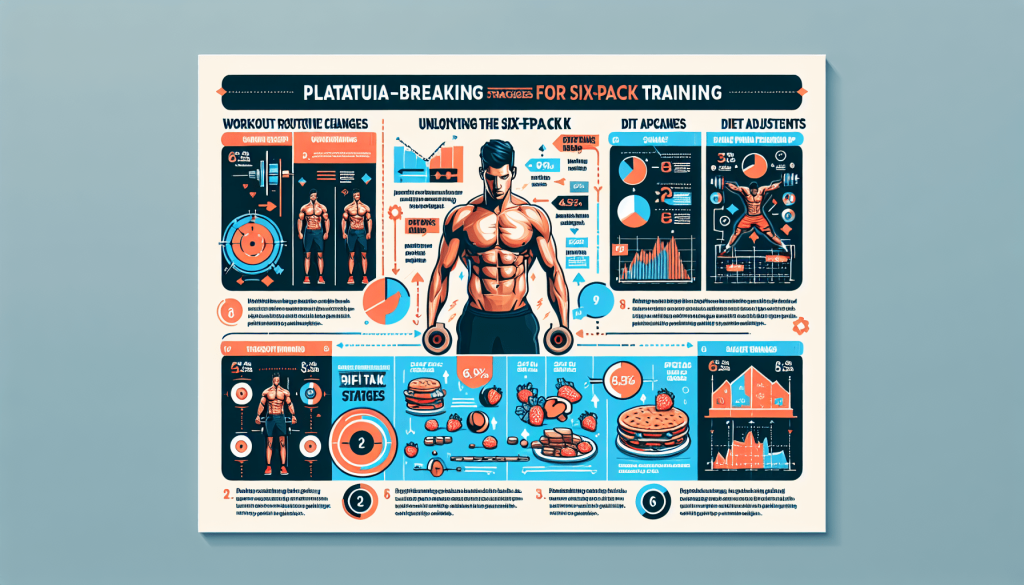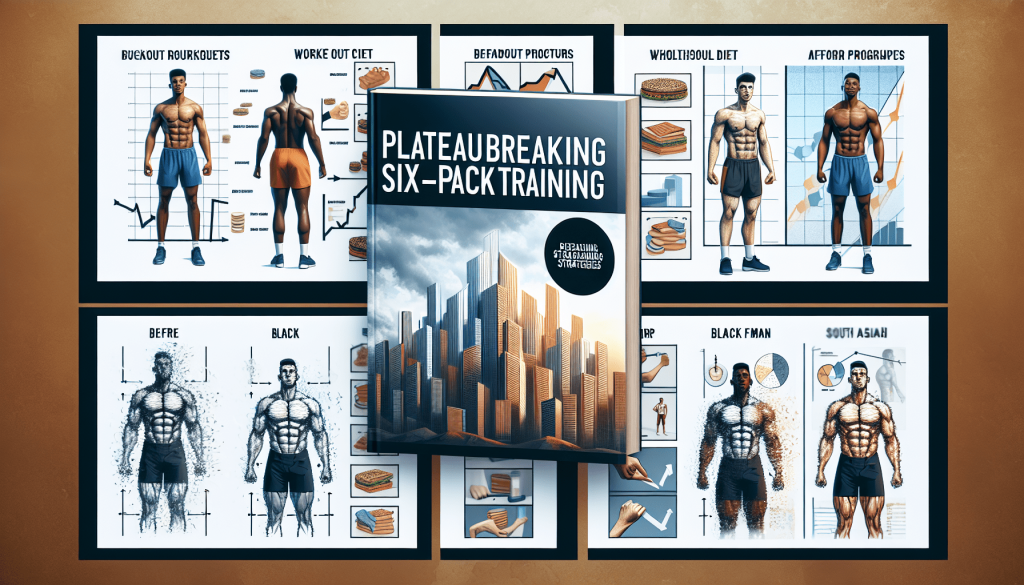Are you tired of hitting a plateau in your six-pack training? Frustrated with your lack of progress and unsure of what to do next? Look no further, because this article has got you covered. We will explore some common plateau-breaking strategies for six-pack training that will help you break through those stubborn barriers and achieve the rock-hard abs you’ve always dreamed of. Whether you’re a fitness enthusiast or just starting your journey towards a stronger core, these strategies will provide valuable insights and guidance to take your training to the next level. Say goodbye to plateaus and hello to a stronger, more defined midsection!
Varying Your Exercises
When it comes to reaching your fitness goals, including a variety of exercises in your routine is crucial. Doing the same exercises over and over can lead to a plateau in your progress and can get monotonous. By introducing new exercises, you challenge your muscles in different ways and keep your workouts exciting.
Introduce new exercises
To break through plateaus and continue to see progress in your six-pack training, it’s important to regularly introduce new exercises. This allows you to target different muscle groups and engage your core from various angles. By including exercises like bicycle crunches, Russian twists, and planks with leg lifts, you can challenge your abs in new and effective ways. Don’t be afraid to try different variations and modifications to keep your workouts fresh and engaging.
Increase weight or resistance
Another way to keep progressing in your journey towards a six-pack is to increase the weight or resistance you are using. This can be done by using dumbbells or resistance bands during exercises such as weighted crunches or cable woodchoppers. By gradually increasing the load, you force your muscles to adapt, leading to increased strength and definition in your abs. Just remember to start with a weight that challenges you but still allows you to maintain proper form.
Manipulate the number of reps and sets
Varying the number of reps and sets you perform is another effective strategy to break through plateaus. For example, if you’ve been doing three sets of 12 reps for a certain exercise, try increasing the number of sets to four or adding a couple of extra reps to each set. You can also incorporate drop sets, where you gradually decrease the weight after each set, to further challenge your muscles. By manipulating these variables, you keep your workouts interesting and ensure that your abs are continuously working hard.
Implementing High-Intensity Interval Training (HIIT)
High-intensity interval training, or HIIT, is a popular and effective method for improving cardiovascular fitness and burning calories. It involves alternating between short bursts of intense exercise and periods of rest or low-intensity exercise. Incorporating HIIT into your training routine can help you break through plateaus and achieve your six-pack goals.
Incorporate HIIT cardio workouts
One way to incorporate HIIT into your training is by including HIIT cardio workouts. This can involve exercises such as sprinting, burpees, or jumping jacks performed at a high intensity for a short period of time, followed by a brief rest period. This helps to increase your heart rate, burn calories, and improve your overall cardiovascular endurance. By regularly including HIIT cardio workouts in your routine, you can boost your metabolism and accelerate your progress towards a six-pack.
Include HIIT exercises in your abdominal routine
In addition to incorporating HIIT cardio workouts, you can also include HIIT exercises in your abdominal routine. This involves performing exercises that target your abs at a high intensity, with short rest periods in between. Examples of HIIT ab exercises include mountain climbers, plank jacks, and Russian twists with a medicine ball. By combining these exercises with the principles of HIIT, you can effectively challenge your abs and break through plateaus in your six-pack training.

Prioritizing Progressive Overload
Progressive overload is a fundamental principle of strength training that involves gradually increasing the demands placed on the muscles over time. By prioritizing progressive overload in your training, you can continue to see improvements in both strength and aesthetics in your abdominal muscles.
Gradually increase the intensity of your workouts
One way to prioritize progressive overload is by gradually increasing the intensity of your workouts. This can be done by adding more weight to your exercises, increasing the resistance on your equipment, or performing more challenging variations of exercises. For example, if you’ve been doing regular crunches, you can progress to weighted crunches or decline sit-ups. By consistently pushing yourself to lift heavier or perform more challenging exercises, you stimulate muscle growth and promote the development of your six-pack.
Focus on constant improvement
Building a six-pack is a journey that requires consistent effort and dedication. One key aspect of this journey is focusing on constant improvement. Instead of getting complacent with your current level of progress, strive to always do better than your previous workouts. This can involve aiming to do one more rep or lifting slightly heavier weights each time you train. By adopting this mindset of constant improvement, you ensure that you are always challenging yourself and breaking through plateaus.
Implement advanced abdominal exercises
As you progress in your six-pack training, it’s important to incorporate more advanced abdominal exercises into your routine. These exercises, such as hanging leg raises, dragon flags, and windshield wipers, target the core muscles in a more intense and challenging way. By incorporating these advanced exercises, you continue to stimulate your abs and encourage further development and definition. Just make sure to prioritize proper form and gradually progress to these exercises as you build strength and stability.
Incorporating Circuit Training
Circuit training is a time-efficient and effective way to combine both strength and cardiovascular exercises into one workout. By incorporating circuit training into your routine, you can maximize calorie burn, increase muscular endurance, and overcome plateaus in your six-pack training.
Combine strength and cardio exercises
The key to circuit training is to combine strength exercises with cardiovascular exercises, all performed back to back with minimal rest in between. For example, you can perform a set of squats immediately followed by a set of jump squats, then move on to push-ups and mountain climbers. This combination of exercises challenges both your muscles and cardiovascular system, leading to increased calorie burn and overall fitness. By regularly incorporating circuit training into your routine, you can target your abs from different angles and overcome plateaus.
Minimize rest time between exercises
To ensure the effectiveness of circuit training, it’s important to minimize rest time between exercises. This keeps your heart rate elevated, increases the metabolic demands on your body, and helps to improve your cardiovascular fitness. Aim to take only a short rest between each exercise, just enough to catch your breath and prepare for the next one. By minimizing rest time and keeping the intensity high, you can make the most out of your circuit training workouts and see progress in your six-pack training.

Utilizing Supersets and Drop Sets
Supersets and drop sets are two advanced training techniques that can help you overcome plateaus and push your abdominal muscles to new limits.
Perform supersets for targeted abdominal muscles
Supersets involve performing two different exercises back to back without resting in between. By targeting the same muscle group with each exercise, you effectively fatigue your muscles and stimulate growth. For example, you can perform a set of cable crunches immediately followed by a set of hanging leg raises. This combination of exercises targets your abdominal muscles from different angles and intensifies the workout. By incorporating supersets into your routine, you can break through plateaus and see improved definition in your six-pack.
Incorporate drop sets to increase muscle fatigue
Drop sets are another technique that can be useful in overcoming plateaus in your six-pack training. With drop sets, you start with a heavier weight and perform a certain number of reps until failure. Once you reach failure, immediately decrease the weight and continue the exercise for more reps. This technique increases muscle fatigue and allows you to push your muscles to their limits. For example, you can start with decline sit-ups using a weight plate, then drop the weight and continue with regular sit-ups. By incorporating drop sets into your ab exercises, you can challenge your muscles in new ways and overcome plateaus in your training.
Implementing Periodization Training
Periodization training involves dividing your training into specific periods or phases, each with a different focus. By implementing periodization in your six-pack training, you can optimize your progress, prevent plateaus, and ensure well-rounded development of your abdominal muscles.
Divide your training into different phases
To implement periodization training, you can divide your training into different phases, typically ranging from 4-12 weeks. Each phase focuses on a specific aspect of your six-pack training, such as strength, hypertrophy (muscle growth), or endurance. During the strength phase, you would prioritize heavy weights and low reps, while during the hypertrophy phase, you would focus on moderate weights and higher reps. By dividing your training into these different phases, you ensure that you are progressively challenging your abs and continuously making gains.
Focus on strength, hypertrophy, and endurance in specific periods
In addition to dividing your training into different phases, it’s important to focus on strength, hypertrophy, and endurance during specific periods. This allows you to target different aspects of your abdominal muscles and prevent plateaus. During the strength phase, you would perform exercises with high resistance and low rep ranges to build raw strength. In the hypertrophy phase, you would focus on moderate weights and higher rep ranges to promote muscle growth. Lastly, during the endurance phase, you would prioritize exercises with low resistance and high rep ranges to improve muscular endurance. By strategically incorporating these different training focuses, you can optimize your progress and see continued improvements in your six-pack training.

Ensuring Proper Nutrition and Hydration
Proper nutrition and hydration play a vital role in achieving your six-pack goals. Without a balanced diet and adequate hydration, your body may not have the necessary fuel and nutrients to build and maintain lean muscle mass.
Follow a balanced diet
Eating a balanced diet is crucial for fueling your workouts, promoting muscle recovery, and maintaining overall health. Focus on consuming a variety of nutrient-dense foods, including lean proteins, whole grains, fruits, vegetables, and healthy fats. Avoid excessive amounts of processed foods, sugary drinks, and unhealthy snacks. By fueling your body with the right nutrients, you provide it with the energy it needs to perform at its best and support the development of your abdominal muscles.
Consume adequate protein
Protein is a key macronutrient that plays a crucial role in muscle repair and growth. To support your six-pack training, aim to consume an adequate amount of protein each day. Good sources of protein include lean meats, poultry, fish, eggs, beans, legumes, and dairy products. Consider incorporating a protein shake or smoothie into your post-workout routine to ensure you’re getting enough protein for optimal recovery. By prioritizing protein intake, you provide your muscles with the building blocks they need to grow and become more defined.
Stay hydrated
Staying properly hydrated is essential for optimal athletic performance and overall health. Water is involved in numerous bodily processes, including muscle contraction and nutrient transport. Aim to drink an adequate amount of water throughout the day, especially during and after your workouts. Dehydration can lead to decreased performance, muscle cramps, and fatigue, so it’s important to prioritize hydration for both your overall well-being and your six-pack training.
Getting Sufficient Rest and Recovery
While it may be tempting to constantly push yourself in pursuit of a six-pack, it’s important to prioritize rest and recovery. Your muscles need time to repair and rebuild, and sufficient rest is crucial for preventing injury and maintaining long-term progress.
Allow time for muscle repair
After intense workouts, your muscles need time to recover and repair. It’s during the recovery process that your muscles grow stronger and more defined. Allow at least 48 hours of rest between intense ab workouts to ensure that your muscles have adequate time to recover. Overtraining can lead to muscle imbalances, decreased performance, and increased risk of injury, so it’s important to listen to your body and prioritize rest.
Get enough sleep
Sleep is a crucial component of the recovery process and plays a vital role in muscle repair, hormone regulation, and overall well-being. Aim to get seven to nine hours of quality sleep each night to support your six-pack training. Lack of sleep can lead to decreased energy levels, impaired cognitive function, and hindered muscle recovery. By making sleep a priority, you give your body the opportunity to recharge and ensure optimal progress in your fitness journey.
Incorporate rest days
In addition to getting enough sleep, it’s important to incorporate rest days into your training routine. Rest days allow your muscles and central nervous system to fully recover and reduce the risk of overuse injuries. Use your rest days to engage in light activities such as stretching, yoga, or gentle walks. This active recovery can help increase blood flow and promote muscle relaxation. By giving yourself regular rest days, you ensure that you’re taking care of your body and giving it the time it needs to thrive.

Tracking and Monitoring Progress
To stay motivated and monitor your progress in your six-pack training, it’s important to keep track of your workouts and measure your body composition regularly.
Keep a workout journal
Keeping a workout journal is a great way to stay organized and track your progress. Write down the exercises you perform, the number of reps and sets, and the weight or resistance used. This allows you to see your progression over time and identify areas where you can push yourself further. Additionally, recording how you felt during each workout can help you make adjustments to ensure that you’re consistently challenging yourself and breaking through plateaus.
Regularly measure body fat percentage and muscle definition
In addition to tracking your workout performance, regularly measuring your body fat percentage and muscle definition can provide valuable insights into your progress. Tools such as calipers, bioelectrical impedance scales, or even visual assessments can be used to estimate body fat percentage and track changes in muscle definition. By regularly measuring these metrics, you can objectively assess your progress and make necessary adjustments to your training and nutrition plans.
Seeking Professional Guidance
If you’re struggling to break through plateaus in your six-pack training or have specific issues or goals, seeking professional guidance can be highly beneficial.
Consult a personal trainer
A personal trainer can provide personalized guidance, create a tailored training program, and help you stay accountable in your journey towards a six-pack. They can assess your current fitness level, identify areas for improvement, and provide coaching on proper form and technique. A personal trainer can also help you set realistic goals and adjust your training program as needed to ensure continuous progress.
Work with a nutritionist
Nutrition plays a significant role in achieving a six-pack, and working with a nutritionist can provide expert guidance on optimizing your diet for your goals. A nutritionist can assess your current eating habits, identify areas for improvement, and create a customized meal plan that supports your six-pack training. They can also offer education on portion control, macronutrient distribution, and supplementation if necessary.
Consider physical therapy for specific issues
If you’re experiencing specific issues or injuries that hinder your six-pack training, seeking the guidance of a physical therapist can be beneficial. They can assess your posture, movement patterns, and any imbalances or weaknesses that may be affecting your progress. A physical therapist can provide exercises and techniques to address these issues, improve muscle imbalances, and prevent future injuries. By addressing underlying biomechanical or functional issues, you can pave the way for improved performance and aesthetics in your abdominal muscles.
In conclusion, breaking through plateaus in your six-pack training requires a combination of strategies that target different aspects of your fitness journey. By varying your exercises, implementing high-intensity interval training, prioritizing progressive overload, incorporating circuit training, utilizing supersets and drop sets, implementing periodization training, ensuring proper nutrition and hydration, getting sufficient rest and recovery, tracking and monitoring progress, and seeking professional guidance when needed, you can overcome plateaus and continue making strides towards achieving your six-pack goals. Stay consistent, stay motivated, and enjoy the journey towards a strong and defined core.






